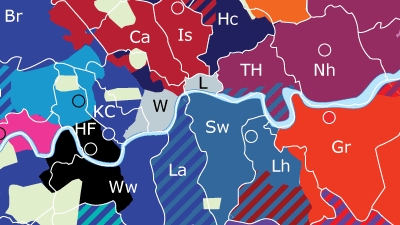Football Fanlands of London

“Football isn’t a matter of life and death, it’s much more important than that,” is a quote often attributed (1) to Bill Shankly, the legendary manager of Liverpool FC. As exaggerations go, this one gets pretty close to the truth. Millions of fans identify intensely with the highs and lows of their favourite sports team, perhaps a modern substitute for the tribal loyalties of bygone days.
Fandom is a bit more complicated than mere tribalism, though. Which team you support is the result of an intricate compound of ancestral, regional, social, and sometimes even religious loyalties. And, of course, personal choice. However, this map of London seems to indicate that geography is a major factor in fan loyalty.

It shows the clear geographical slant of football (2) fandom in the British capital: the centres of gravity for each ‘fanland’ tend to be around the home grounds of each team.
As with other fan loyalty maps (3), this one has a decidedly feudal feel to it. None of the clear, straight delineations of modern borders, but lots of fuzzy boundaries, transitional zones, and enclaves in ‘enemy’ territory.
Some teams command great swathes of territory, for example West Ham United FC. This Premier League club dominates the east of London, in particular the boroughs of Havering [Ha], Barking and Dagenham [BD], Redbridge [Rb], Newham [Nh] and Tower Hamlets [TH].
Barking and Dagenham, West Ham heartland, contains an enclave where loyalty is shared with Dagenham and Redbridge FC, recently promoted from Football League Two to One. However, the Daggers are – literally – not in West Ham’s league; loyalties for both teams therefore probably are complementary rather than conflictual.
Other fanlands are more compact than West Ham’s, like that of Fulham FC. From Craven Cottage, its grounds on the banks of the Thames, this club commands an undisputed, but relatively small territory in the boroughs of Hammersmith and Fulham [HF] (north of the river), most of Wandsworth [Ww] and part of Richmond upon Thames [RT] (both south of the river).
Nearby rival Chelsea, based at Stamford Bridge (also in Hammersmith and Fulham rather than the neighbouring borough of Kensington and Chelsea [KC]), is master of a much more fragmented, but also much larger domain, extending from its core in Kensington and Chelsea all the way north to the northeastern corner of Barnet [Ba], taking in most of Brent [Br], south to Kingston upon Thames [KT], west to Lambeth [La] (a grey zone shared with Millwall) and east to Hillingdon [Hi], an area disputed with Queens Park Rangers that extends back into Ealing [Ea], the western part of which is QPR-only territory.
Arsenal is big in its home borough of Islington [Is], and in Camden [Ca] and Barnet. It commands a similar archipelago of loyalty throughout London (4), but has to share north London with Tottenham Hotspur, which rules over most of Enfield [En], Haringey [Hr] and Hackney [Hc]. Loyalty to the Spurs seems to be confined to that area, however, except for two small patches in Westminster [W].
The whole of London thus constitutes a wildly patterned patchwork of fanlands, the demarcation and location of which will probably be hotly debatable to any local football fans. The white patches in between the coloured bits possibly are football-free zones, self-selected sanctuaries for dissenters from England’s secular religion of footie. Or they just might be the parks of London.
Many thanks to Paul Maidment for sending in this map, found here on qprdot.org, a messageboard for Queens Park Rangers fans.
Strange Maps #496
Got a strange map? Let me know at strangemaps@gmail.com.
——————–
Since we’re discussing sports geography, a small encore. This map shows the so-called Barassi Line in Australia, first posited in 1978 as running in a straight line from the Northern Territory/Queensland border to the border of Victoria and New South Wales.The line denotes a peculiar sports dichotomy that seems to have persisted since the 1850s. West and south of the line, Australian rules football is the more popular sport, while varieties of rugby football are more popular east and north of it.
“As an Australian myself, this map has always interested me because there is no other major cultural divide in Australia, and as far as I know no historical reason for the differences between NSW & QLD and the rest of Australia,” says Andrew Simon Goard, who sent in this map, found here on Wikipedia.

——————–
(1) Somewhat streamlined. In the actual quote, on Granada TV in 1981, Shankly related a conversation he had: “Someone said ‘football is more important than life and death to you’, and I said ‘listen, it’s more important than that’.”
(2) That’s the original football, called soccer in the United States (although that term, too, originated in England). The other game, the one with the helmets, is American football. Except in America, where the geographic adjective is redundant, and you are allowed to call it football – if you must. Here is an interesting map showing the distribution of the terms soccer and football across the anglosphere.
(3) See #160 for a map of the United Countries of Baseball, a similar map plotting regional team loyalties across the US.
(4) mainly throughout London’s western half, although there is an Arsenal-minded patch in Lewisham [Lh] in southeast London – incongruously, for in general football loyalties seem to transfer worse from east to west than north to south.





